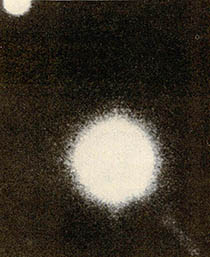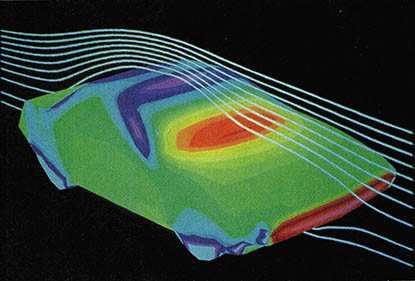
하늘에서 새로운 것을 찾아내는 일은 언제나 흥분을 불러일으키지만, 광장히 먼 거리에 있는 새로운 그 무엇을 찾아내는 일은 바로 천문학자들이 '이중 퀘이사'를 발견해 냈던 것처럼 곱절이나 그러하다. 우리가 이렇게 먼거리에서 보는 것들은 모두 우주의 청년기에 존재했던 것들이며, 천문학자들은 이 초창기에 관해 가능한한 많은 것을 밝혀내려고 갈망하고 있다.
1963년 먼 곳에 대한 연구는 퀘이사들이 처음 발견되면서부터 시작되었다. 이것들은 희미한 별들처럼 보이지만 십억광년 이상의 거리에 존재함이 밝혀졌다. 현재 그것들은 수백개가 탐지되었는데, 몇몇은 1백억 광년이나 멀리 있다.
우리는 그보다 훨씬 더 멀리 볼 수는 없다. 이것은 우리가 우주의 끝(우주에 끝에 없다)까지 꿰뚫어 보고 있기 때문이 아니라, 더욱더 멀리 떨어진 물체를 보면 볼수록 우리는 더욱 더 먼 과거를 보고 있는 것이 되기 때문이다. 1백억 광년 떨어져 있는 퀘이사는 우주가 아주 어렸을 때인 1백억 년 전의 것으로 보인다. 만약 우리가 더 멀리까지 꿰뚫어 볼 수 있다면, 우리는 아직 은하마저도 형성되지 않았고 뜨거운 열을 방사하는 구름이 단지 불투명한 안개로 보이는 그러한 우주를 보개 될지도 모른다.
퀘이사가 그런 거리에서 보이기 위해서는 그것들은 보이는 것처럼 별들일 수는 없고 완전한 은하들이어야 한다. 가령 우리의 은하수와 같은 보통의 은하는 그렇게 먼거리에서는 보이지 않을 것이지만, 퀘이사들은 어떤 이유론지 보통 은하들보다 1백 배나 더 밝은 빛을 발산하는 거대한 활동중심을 가지고 있다. 이 결과로 그것들은 우리가 꿰뚫어 볼 수 있는 가장 먼 거리에서도 보이는 것이다.
아주 오래 전에는 지금 존재하는 것보다 더 많은 지극히 활동적인 은하들이 있었을 것으로 여겨진다. 젊은 은하들이 퀘이사로 되기가 보다 쉬울까? 무엇이 중심을 그렇게 빛나게 만드는가?
그런 동력을 주는 에너지의 근원은 무엇인가? 다 타버렸을 때 퀘이사에겐 어떤 일이 일어나나?
천문학자들은 퀘이사들에 대해서 답을 얻고 싶어하는 많은 질문들을 가지고 있다.
거의 20년동안 퀘이사들은 단지 물체로만 보여져왔다. 그러다가 80년대 초에는 때때로 '이중 퀘이사'가 발견되기도 했다. 두 개의 퀘이사가 서로 대단히 근접해 있는 것이 관측되었다. 그때까지 전파망원경와 광학망원경으로 퀘이사를 연구하는 기술이 많이 향상되어 퀘이사에서 나온 빛이 자세하게 분석될 수 있었다.
아주 가까이 이웃해 있는 두개의 퀘이사 각각으로부터 나온 빛은 모든 특성이 같다는 사실이 밝혀졌다. 두개의 독립된 퀘이사가 있는 것처럼 보이지만 사실은 하나의 퀘이사가 무언가의 이유로 두개로 보이게 된 것이다. 어떻게 그럴 수 있을까?
논리적 답변은 이렇다. 하나의 퀘이사로부터 나온 빛은 우리를 향해 다가오는 동안 퀘이사와 우리들 사이에 있는 어떤 보통의 은하를 통과했다. 이 보통의 은하는 너무 어두워 보이지 않지만 그 중력으로 퀘이사의 빛을 약간 휘게한다. 빛은 은하의 어느쪽에서나 안쪽으로 휘어지며 빛의 일부분은 다른 일부분과 약간 겹쳐지고 우리의 망원경에 도달할때에는 근접한 2중의 빛살로 나타나게 된다. 우리는 따라서 실제로는 하나뿐인데도 두개의 퀘이사를 보게된다.
이런 효과는 '중력 렌즈' 라고 불려지는데 그이유는 보통렌즈와 같은 효과를 나타내기 때문이다. 아인슈타인은 발견되기 70년전에 그것이 존재할지 모른다고 예측했다.
그러한 중력렌즈의 여러 예들이 현재 알려져 있으며, 이들은 실제로는 보이지 않지만 중력렌즈 효과를 일으키는 은하들에 관하여 추론하는데 쓰일 수 있다.
'PKS 1145-071'이라고 목록에 기록된 어떤 퀘이사는 몇년전부터 알려져 왔으며 약 1백억 광년 떨어져 있다. 그것은 단지 또다른 퀘이사로 간주되고 있었지만, 1986년 12월에 이중 퀘이사임이 밝혀졌다. 두 개의 퀘이사가 아주 근접해 있었던 것이다. 자연히 이것도 중력렌즈의 또다른 예로 추측되었다.
1987년 아리조나 다중반사망원경에서 일하던 천문학자들은 이 근접하게 위치한 퀘이사들의 각각으로부터 오는 빛을 분석했다. 최초로 그 빛이 완전히 똑같지는 않음이 판명됐다. 그 퀘이사들은 이중으로 보이는 하나의 물체가 아니라 분리된 두개의 물체임을 보여주는 뚜렷한 차이가 있었다.
만약 이러한 관찰이 맞는다면 PKS 1145-071은 진정한 이중 퀘이사로 발견된 첫번째 예가 될것이다. 그것은 충분히 가까운 위치에 거대한 활동중심들을 가진 두 은하들이 서로 회전하고 있음을 의미하게 될 것이다. 만일 그렇다면, 이 두개의 은하들은 스스로의 힘만으로 존재하지 않을 가눙성이 있다. 그 근처에는 퀘이사가 아니고, 강력한 활동중심을 가지지 않으며 따라서 보이지도 않는 다른 은하들이 있을지도 모른다. 간단히 말해서, 우리가 은하들의 무리를 보고 있을 확실한 가능성이 있을 것 같다.
은하들은 무리지어 존재한다. 우리의 은하수는 24개의 은하들의 한 부분이고, 수천개의 은하를 가진 무리들도 알려져 있다. 하지만 새로운 발견은 그러한 무리들이 이미 1백억년 전에 존재했을 지도 모른다는 것을 보여 주고 있다. 만약 그렇다면 이것은 천문학자들로 하여금 은하들이 최초에 어떻게 형성되었는가에 대한 그들의 견해들을 가다듬게 만들것이다.
Finding something new in the sky is always exciting, but finding something new at an enormous distance-as astronomers have just done, in the form of a "double quasar"-is doubly so. Anything we see at such a distance existed in the youth of the universe and astronomers simply hunger to find out as much as they can about those early days.
In 1963, the study of the far distance began when quasars were first discoverded. These look like faint stars but they were found to be at distances of a billion light-years or more. Hundreds of them have now been detected, and some are 10 billion light-years away.
We can't see much farther than that. This is not because we are penetrating to the end of the universe (there is no end) but because as we look at things farther and farther away, we are looking farther and farther back in time. A quasar that is 10 billion light-years away is seen as it was 10 billion years ago, when the universe was quite young. If we could penetrate further we might be viewing a universe in which galaxies had not yet formed and in which clouds of hot radiation would be seen only as an opaque fog.
For quasars to be visible at such a distance, they cannot be stars as they seem, but must be whole galaxies. An ordinary galaxy, such as our own Milky Way, would not be visible at that distance, but quasars have enormously active centers that for some reason blaze with a light 100 times as intense as that of ordinary galaxies. The result is they can be seen at even the farthest distances we can penetrate. There seem to have been more such super active galaxies long ago than there are now. Are young galaxies more apt to be quasars? What makes the centers so bright? What is the source of energy that powers them? What happens to a quasar when it finally "burns out"?
Astronomers have many questions about quasars they would like answered.
For nearly 20 years, quasars were seen only as singe objects; then in the early 1980s, an ocasional "double quasar was seen. Two quasars would be detected that were very close to each other. By then, the techniques for studying quasars by radio telescopes as well as by optical ones had been much improved, and their light could be analyzed in detail.
It turned out that the light from each of these two very closely neighboring quasars were identical in all characteristics. It was not as though there were two separate quasars, but a single quasar which, for some reason, was seen double. How could that be?
The logical answer was that the light from a quasar, as it traveled toward us, passed an ordinary galaxy that existed between it and ourselves. This ordinary galaxy was too dim to see, but its gravitational pull bent the quasar's light a tiny bit. The light was bent inward on either side of the galaxy so part of the light crossed the other part very slightly and ended up in our telescopes as a closely spaced double beam. We therefore see two quasars where there actually is only one.
This effect is called a "gravitational lens" because it produces the same effect that an ordinary lens would. Albert Einstein predicted that such a phenomenon might exist 70 years before it was discovered.
Several examples of such gravitational lenses are now known and they can be used to make deductions about the galaxies that produce the effect even though those galaxies cannot actually be seen.
A certain quasar, listed in the catalogues as "PKS1145-071," has been known for years and is about 10 billion light-years away. It had always seemed just another quasar, but in December, 1986, it was found to be double. There were two quasars there, very close together. It was naturally assumed to be another case of a gravitational lens.
In 1987, astronomers at the Multiple Mirror Telescope in Arizona analyzed the light from each of these closely spaced quasars. For the first time, the light turned out to be not quite identical. There were distinct differences that indicated that the quasars were not a single object seen double, but were two separate objects.
If this observation holds up, then PKS1145-071 would be the first case that has been discovered of a true double-quasar. It would represent two galaxies with enormously active centers at sufficiently close quarters to be circling each other.
If this is so, it is possible that these two galaxies do not exist all by themselves, There may be other galaxies in the vicinity that are not quasars, that do not have super-active centers, and that are therefore invisible. In short, there seems to be a distinct possibility that we are looking at a cluster of galaxies. Galaxies do exist in clusters. Our own Milky Way is part of a cluster of two dozen galaxies, and other clusters with thousands of members are known. However, the new discovery would show that such clusters may already have existed 10 billion years ago. If so, that would force astronomers to sharpen some of their views on how galaxies formed in the first place.
(c) 1987, Los Angeles Times Syndicate

















